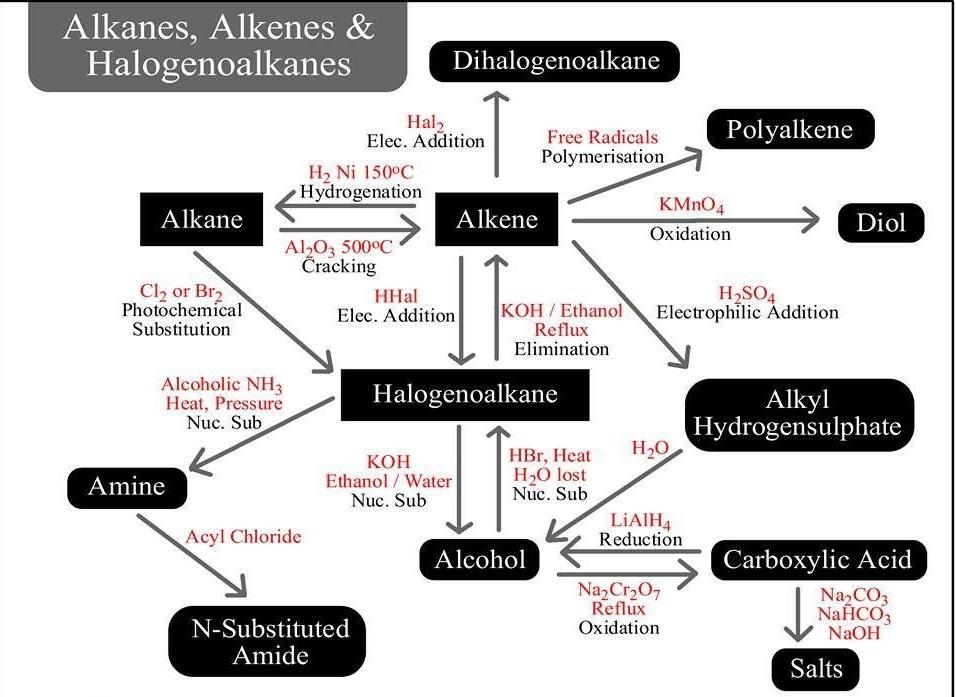Synthetic production of alkyl
Alkyl halides, popularly known as haloalkanes or halogenoalkanes, are chemical compounds comprising at least one halogane. Although there is no clear differentiation, they are a distinctive subset of halocarbons. The compounds are widely used in different industries and, consequently, are identified by various names (Kursunlu et al., 2019). The classification of haloalkanes is based on how the halogen is connected to carbon atoms. Primary haloalkanes contain one halogen connected to an alkane group, as in the case of chloroethane. The compounds are physically characterized as hydrophobic, colorless, and odorless. The production of haloalkanes is conventionally achieved from the constituent organic compounds. The reaction used in the above case is called radical chain reaction due to the presence of an intermediary. The reaction gives rise to a set of mixtures at different stages of the reaction. The end products of the reaction can be predicted by studying the resultant bonging of the carbon and halogen atoms. The prediction can be built on the dissociation energies released as the atoms separate or join. The end products can also be predicted by looking at the possible reaction at the carbon-atom level. The dipole moments suggest it is likely to break down the compounds through distillation. Halogens can also be produced from alcohol through a nucleophilic reaction. Alcohol reacts with halogen acid to produce haloalkanes. In this case, hydrochloric acid is reacted with alkanol producing an alkyle chloride. However, if a primary acid is chosen, the reaction then needs to include an activator, as in the case of the Lucas test. Alkynes and alkenes are other synthetic sources of haloalkanes. In this case, hydrogen halides such as hydrogen bromide and hydrogen chloride react with an alkene to produce mono-haloalkanes.
Synthetic route for octane using 1-bromoheptane and iodomethane
Octane is one of the most flammable compounds found in petroleum products. It comprises hydrogen and carbon atoms, and we may not realize how we often buy this product in gas stations. This compound is a major symbol of the quality of petroleum fuels. Just like all other compounds that have low molecular weights, octane is highly flammable and volatile. Octane is an alkane and also a hydrocarbon comprised of hydrogen and carbon atoms. The chemical formula of octane is C8H18. The formula can be compressed as CH3(CH2)6CH3. Octane has several structural isomers that differ depending on the number of carbon atoms and the branching of the atoms. 1-Bromobutane (CH3(CH2)3BR reacts with a hydride to produce octane. By definition, 1-bromobutane contains one atom of bromide in its chemical formula and is colorless. However, in the presence of impurities, the liquid appears yellowish depending on the intensity of the impurities., the compound dissolves in an organic solvent but not in water. On a different note, methyl iodide, popularly known as iodomethane, is chemically denoted as CH3I. According to Parker (2017), iodomethane is emitted by rice plantations naturally. When reacted with hydrogen iodide, an iodine atom replaces one hydrogen atom producing an iodide product. The resultant product is then reacted with a hydride such as a hydrogen chloride or hydrogen bromide to produce octane. One of the hydrogen atoms in the iodomethane is displaced in the reaction; the hydride produces octane.
The reaction scheme for isomers is illustrated in the figure below.

Reaction mechanism and product structure
Sodium cyanide is a reactive compound of the highly reactive sodium element. The compound is comprised of sodium, carbon, and nitrogen atoms. 2-bromooctane is a complex compound comprised of carbon, hydrogen, and bromine atoms. Its chemical formula is C4H9Br. The compound is quite denser than water and has a relatively higher boiling point as compared to water. Dimethylsulfoxide (DMSO) is a human medication prescribed wit people with dietary problems. The medicine is used to contain amyloidosis, where tissues and organs collect proteins abnormality. In the reaction of sodium cyanide with 2-bromobutane, dimethyl sulfoxide acts as an aprotic solvent. Aphotic solvents contain oxygen-hydrogen bonds or nitrogen hydrogen bonds, depending on their chemical formula. The ‘a” present in the classification of the solvents suggests a lack of hydrogen atoms of protons. The aforementioned reaction produces substitution products. Roy and Saha (2018) define a substitution reaction as one in which a molecule or group of atoms from one element or compound replace their counterparts on another atom or compound respectfully. The substitution happens depending on the reactivity of the distinctive elements and the conditions required for such reactions. In our case, the (R)-2-bromooctane molecule is comprised of 8 carbon atoms, 17 hydrogen atoms, and one bromine atom. Likewise, sodium cyanide is comprised of one sodium atom, one nitrogen, and one carbon atom. The solvent four carbon atoms, six hydrogen atoms, one sulfur atom, and one oxygen atom. When (R)-2-bromooctane reacts with NaCN in the presence of DMSO, the DMSO establishes the ideal environment needed for the reactions of the two compounds (Hu et al., 2017). In the process of the reaction, the different faces of the carbon atom are equally filled. In the substitution reaction using the SN1 mechanisms, the reaction gives a mixture of 1:1 irrespective of the starting salts used in the reaction.
References
Dong, X., Peng, W., Yu, C. Y., Zhou, S., Donohoo, K. B., Tang, H., & Mechref, Y. (2019). 8-plex LC-MS/MS Analysis of Permethylated N-glycans Achieved by Using Stable Isotopic Iodomethane. Analytical Chemistry, 91(18), 11794-11802.
Hu, L., Wang, D., Chen, X., Yu, L., Yu, Y., Tan, Z., & Zhu, G. (2017). Copper-catalyzed decarboxylative methylthiolation of aromatic carboxylate salts with DMSO. Organic & biomolecular chemistry, 15(27), 5674-5679.
Kursunlu, A. N., Acikbas, Y., Ozmen, M., Erdogan, M., & Capan, R. (2019). Haloalkanes and aromatic hydrocarbons sensing using Langmuir–Blodgett thin film of pillar [5] arene-biphenyl carboxylic acid. Colloids and Surfaces A: Physicochemical and Engineering Aspects, 565, 108-117.
Roy, R., & Saha, S. (2018). Scope and advances in the catalytic propargylic substitution reaction. RSC advances, 8(54), 31129-31193.